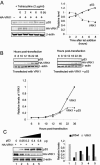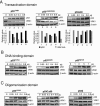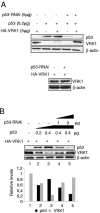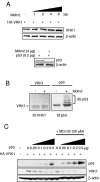p53 downregulates its activating vaccinia-related kinase 1, forming a new autoregulatory loop
- PMID: 16782868
- PMCID: PMC1489172
- DOI: 10.1128/MCB.00069-06
p53 downregulates its activating vaccinia-related kinase 1, forming a new autoregulatory loop
Abstract
The stable accumulation of p53 is detrimental to the cell because it blocks cell growth and division. Therefore, increases in p53 levels are tightly regulated, mainly by its transcriptional target, mdm2, that downregulates p53. Elucidation of new signaling pathways requires the characterization of the members and the nature of their connection. Vaccinia-related kinase 1 (VRK1) contributes to p53 stabilization by partly interfering with its mdm2-mediated degradation, among other mechanisms; therefore, it is likely that some form of autoregulation between VRK1 and p53 must occur. We report here the identification of an autoregulatory loop between p53 and its stabilizing VRK1. There is an inverse correlation between VRK1 and p53 levels in cell lines, and induction of p53 by UV light downregulates VRK1 in fibroblasts. As the amount of p53 protein increases, there is a downregulation of the VRK1 protein level independent of its promoter. This effect is indirect but requires a transcriptionally active p53. The three most common transcriptionally inactive mutations detected in hereditary (Li-Fraumeni syndrome) and sporadic human cancer, p53(R175H), p53(R248W), and p53(R273H), as well as p53(R280K), are unable to induce downregulation of VRK1 protein. The p53 isoforms Delta40p53 and p53beta, lacking the transactivation and oligomerization domains, respectively, do not downregulate VRK1. VRK1 downregulation induced by p53 is independent of mdm2 activity and proteasome-mediated degradation since it occurs in the presence of proteasome inhibitors and in mdm2-deficient cells. The degradation of VRK1 is sensitive to chloroquine, an inhibitor of the late endosome-lysosome transport, and to serine protease inhibitors of the lysosomal pathway.
Figures







Similar articles
-
p53 Stabilization and accumulation induced by human vaccinia-related kinase 1.Mol Cell Biol. 2004 Dec;24(23):10366-80. doi: 10.1128/MCB.24.23.10366-10380.2004. Mol Cell Biol. 2004. PMID: 15542844 Free PMC article.
-
Alteration of the VRK1-p53 autoregulatory loop in human lung carcinomas.Lung Cancer. 2007 Dec;58(3):303-9. doi: 10.1016/j.lungcan.2007.06.023. Epub 2007 Aug 8. Lung Cancer. 2007. PMID: 17689819
-
Downregulation of VRK1 by p53 in response to DNA damage is mediated by the autophagic pathway.PLoS One. 2011 Feb 28;6(2):e17320. doi: 10.1371/journal.pone.0017320. PLoS One. 2011. PMID: 21386980 Free PMC article.
-
The human vaccinia-related kinase 1 (VRK1) phosphorylates threonine-18 within the mdm-2 binding site of the p53 tumour suppressor protein.Oncogene. 2000 Jul 27;19(32):3656-64. doi: 10.1038/sj.onc.1203709. Oncogene. 2000. PMID: 10951572
-
Negative auto-regulators trap p53 in their web.J Mol Cell Biol. 2017 Feb 1;9(1):62-68. doi: 10.1093/jmcb/mjx001. J Mol Cell Biol. 2017. PMID: 28069666 Free PMC article. Review.
Cited by
-
Adult-Onset Spinal Muscular Atrophy due to Mutations in the VRK1 Gene.Neurol Genet. 2021 Jun 22;7(4):e599. doi: 10.1212/NXG.0000000000000599. eCollection 2021 Aug. Neurol Genet. 2021. PMID: 34169149 Free PMC article.
-
Ursolic acid exerts anti-cancer activity by suppressing vaccinia-related kinase 1-mediated damage repair in lung cancer cells.Sci Rep. 2015 Sep 28;5:14570. doi: 10.1038/srep14570. Sci Rep. 2015. PMID: 26412148 Free PMC article.
-
Human VRK1 is an early response gene and its loss causes a block in cell cycle progression.PLoS One. 2008 Feb 20;3(2):e1642. doi: 10.1371/journal.pone.0001642. PLoS One. 2008. PMID: 18286197 Free PMC article.
-
Implication of the VRK1 chromatin kinase in the signaling responses to DNA damage: a therapeutic target?Cell Mol Life Sci. 2018 Jul;75(13):2375-2388. doi: 10.1007/s00018-018-2811-2. Epub 2018 Apr 20. Cell Mol Life Sci. 2018. PMID: 29679095 Free PMC article. Review.
-
Rewiring of human lung cell lineage and mitotic networks in lung adenocarcinomas.Nat Commun. 2013;4:1701. doi: 10.1038/ncomms2660. Nat Commun. 2013. PMID: 23591868 Free PMC article.
References
-
- Agarwal, M. L., W. R. Taylor, M. V. Chernov, O. B. Chernova, and G. R. Stark. 1998. The p53 network. J. Biol. Chem. 273:1-4. - PubMed
-
- Barcia, R., S. Lopez-Borges, F. M. Vega, and P. A. Lazo. 2002. Kinetic properties of p53 phosphorylation by the human vaccinia-related kinase 1. Arch. Biochem. Biophys. 399:1-5. - PubMed
Publication types
MeSH terms
Substances
LinkOut - more resources
Full Text Sources
Research Materials
Miscellaneous
